The Effect of Heating - Simple, Non-Technical Explanation
Heating has a very important role in keeping old buildings dry, comfortable and healthy.
In building conservation it is a widely accepted idea that slow, steady heating and some ventilation is all you need to keep old breathable walls dry. As a result, heating is regarded as a popular building-friendly solution for many dampness problems,
Heating has been believed to fully penetrate damp walls, drying moisture out of them completely. After all, if a wall (such as one made of bricks and lime) is fully breathable with no moisture barriers present, it is a logical assumption that heating should leave the wall fabric completely dry. This assumption, although a simple and nice concept, has never been subject to in-depth testing - until now.
Competing Forces: Heating vs. Soil Evaporation
Recent research has uncovered that the moisture content of old walls is controlled by the co-action of several forces, the most important ones being:
- Heating: natural or artificial heating reaches the wall surfaces, then penetrates under the surface. The penetration depth is not significant; typically less than 20 mm.
- Soil evaporation: the beneficial effect of heating in depth near the ground is primarily cancelled out by the presence of soil evaporation. Water from the soil constantly evaporates upwards. When a wall is built onto the damp soil – blocking the free evaporation of moisture – the moisture from under the wall will first evaporate INTO the porous wall fabric (into the wall capillaries) then into the air.
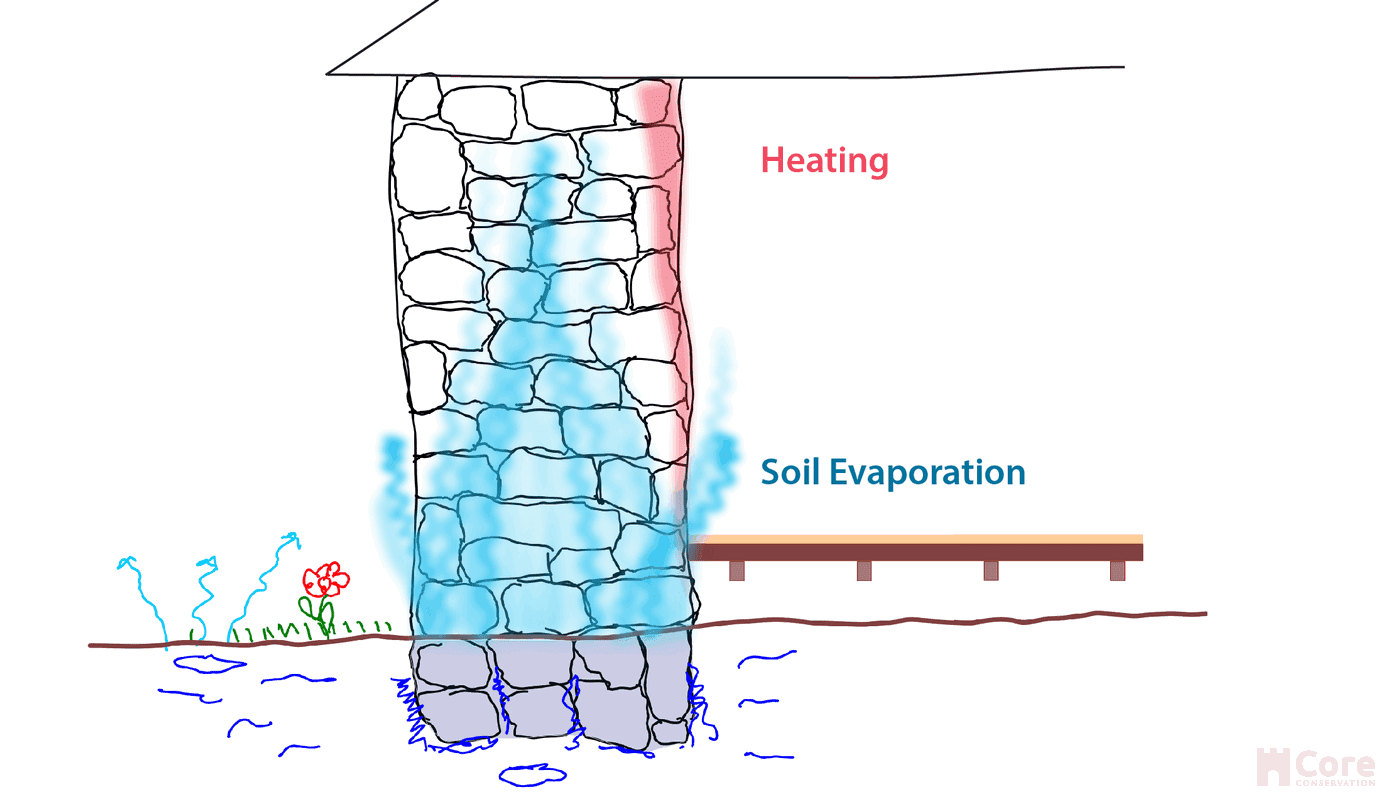
Soil evaporation overrides the effect of heating near ground
These two opposing forces are in constant "competition". Heating tries to make a wall dry, while soil evaporation tries to keep it moisture saturated and damp. The dry or damp state of a masonry at any point is determined by the relative strength of these two forces.
The existence of soil evaporation, an important yet invisible moisture source, has not been observed, and as such it has been completely disregarded by many professionals. This oversight lead to a false assumption that inside old walls there is "nothing" except a small amount of residual moisture which heating can easily deal with. This was incorrect.
Soil evaporation is an important and persistent moisture source near the ground with profound long-term effects to the wall fabric. Being present 24/7 it can cancel out the drying effect of heating. More exactly:
- The surface: heating can dry out wall surfaces, resulting in apparently dry walls. However, under a thin dry "crust" the wall fabric remains damp.
- In depth, higher up the ground: the effect of heating is greatly reduced by soil evaporation as the effect of vertical vapor propagation from the soil can be felt quite high up inside the wall. It is research in progress to determine how deep exactly heat penetrates inside a masonry, but the data so far indicates that not very deep, surface heating not making any significant impact beyond 10-15 mm.
- In depth, close to the ground: the proximity of soil evaporation is the driving force, creating a moisture saturated environment (near 100% relative humidity) close to the ground. This overrides the effect of heating which can't compete with the ongoing 24/7 soil evaporation. As a result the depth of old walls near the ground stays permanently damp, despite all heating and ventilation, even if the surface of the wall looks dry.
Vapors rise, humidity rises and gradually accumulates in the wall fabric. The mysterious - and for many the conflicting and eluding - rising damp is in fact, created by soil evaporation.
Moisture Accumulation - What if the Wall Fabric is Breathable?
It is believed that a breathable wall fabric "naturally" evaporates out all its humidity, resulting in a dry wall.
Here is an interesting question: if we place a fully breathable brick wall onto a well-drained damp soil, only subject to soil evaporation but no capillary action (no liquid moisture is present), will the brick accumulate moisture from the soil, or will moisture evaporate freely leaving the brick dry?
The general assumption is, that vapors from the soil evaporate through the bricks leaving them dry.
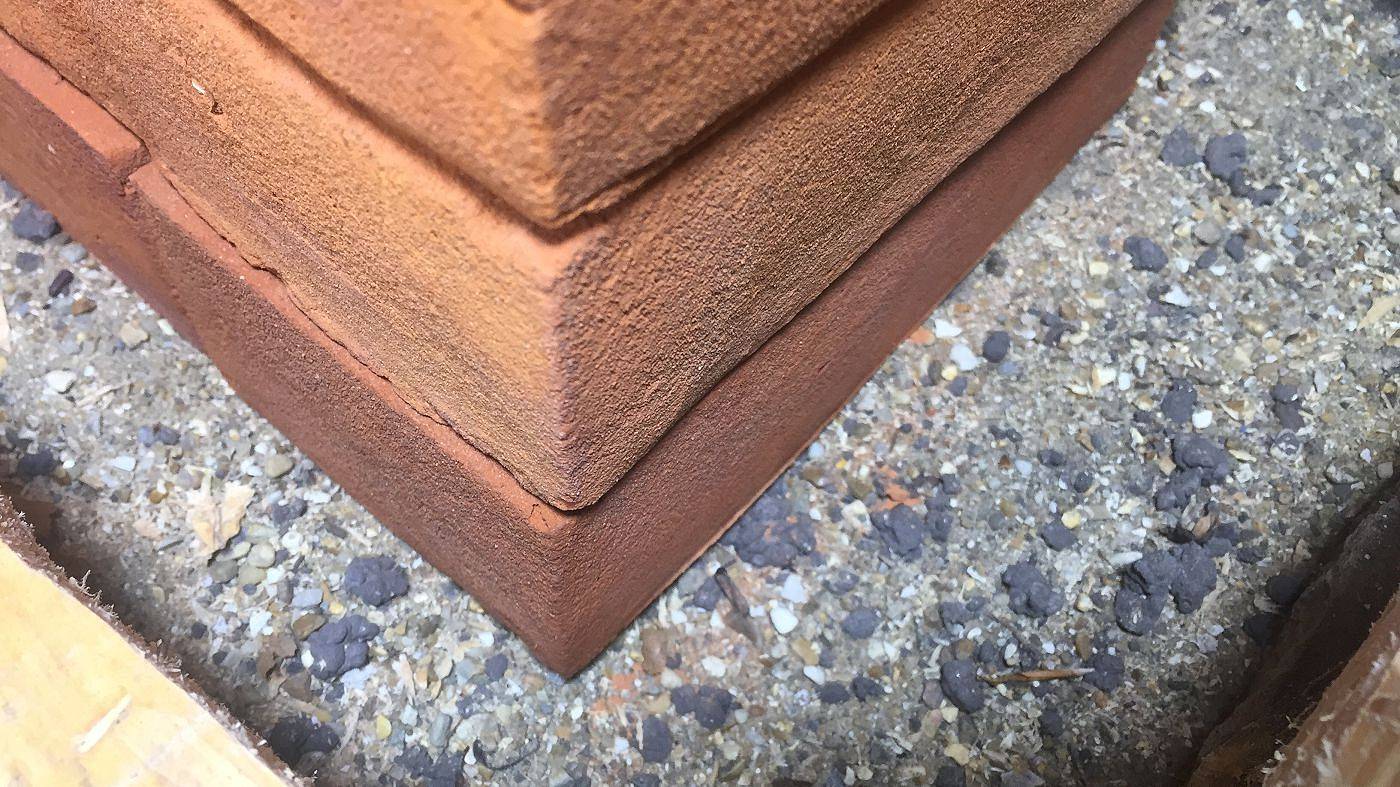
Fully breathable wall on drained, moist soil
Research data, however, has now conclusively proven that this is not the case. Bricks in the vicinity of a well-drained but damp soil do accumulate significant moisture. We can distinguish two different phases:
- Phase 1 - Moisture accumulation: dry bricks placed on damp soil instantly start accumulating moisture. Bricks act as holding tanks, behaving like empty vessels or vacuum, and in the presence of humidity they start collecting moisture. This goes on until they reach some sort of equilibrium with the environment.
- Phase 2 - Evaporation: evaporation only starts after the equilibrium phase has been reached, when the bricks start evaporating out the excess moisture in an attempt to preserve their equilibrium state.
In other words bricks first collect a significant amount of moisture from the ground, reach an equilibrium, and only then start evaporating (breathing out) the excess moisture.
How much moisture can exposed bricks accumulate from soil evaporation alone? The video below demonstrates that as part of an experiment we have conducted earlier.
The Effect of Heating - Technical Research Data
Let’s now look at some of the research data behind some of the concepts discussed earlier including the effects and limitations of heating.
Experimental Setup
To better understand the effects of heating onto old walls we have done a number of experiments on buildings of various ages and wall constructions. More experiments are still under way.
We have embedded an array of moisture sensors into the wall fabric at half-brick intervals – brick 1, mortar course 1, brick 2, mortar course 2, brick 3 etc. – monitoring the penetration of heat and humidity from the outer environment, through the wall surface, into the depth of the fabric.
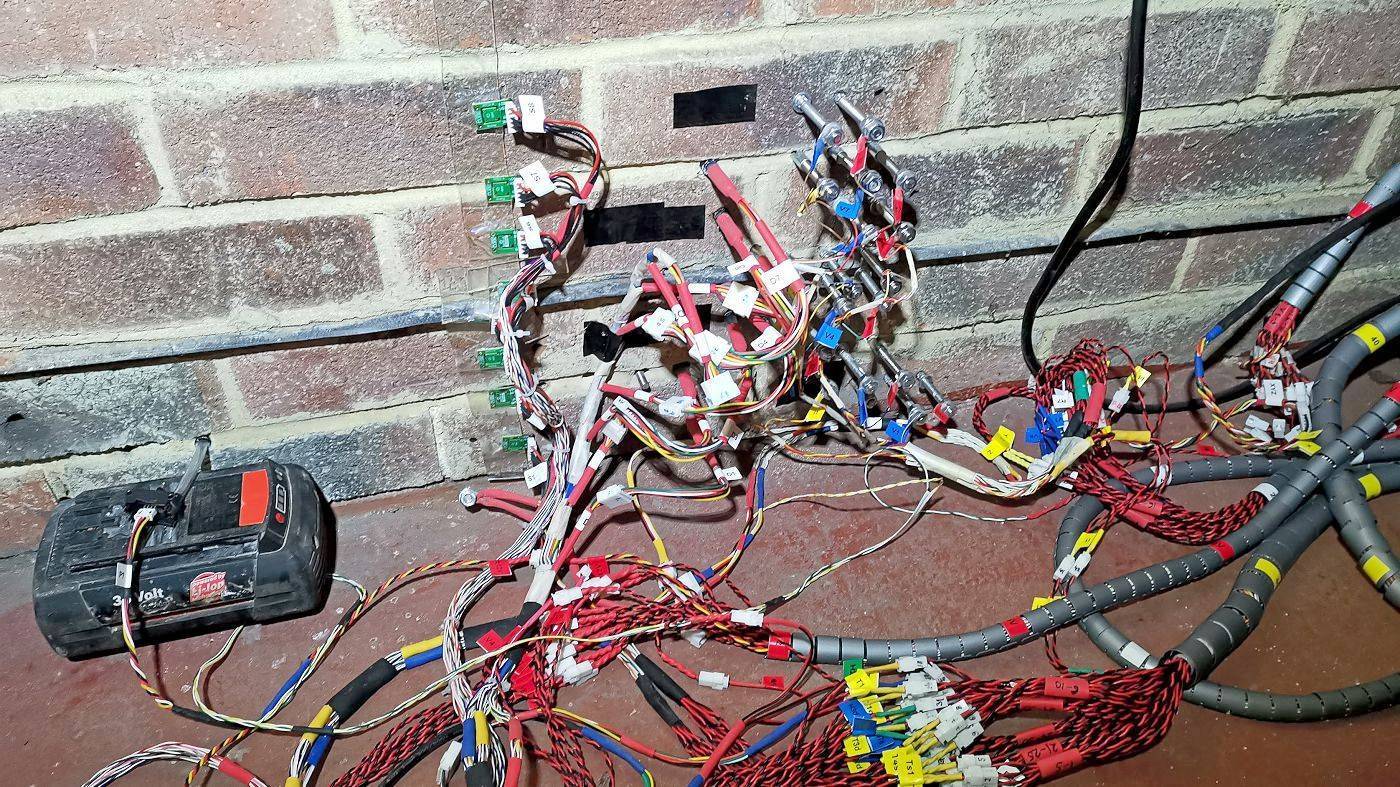
Experimental setup
We have monitored in real-time over 60 parameters of the wall fabric from both depth and surface, taking long-term readings for many weeks every few seconds.

Embedded sensors into the wall fabric
This detailed experimental setup permitted us to:
- Track the movement of moisture: throughout the wall fabric both horizontally (inside-out) and vertically (up-down) through subsequent brick and mortar-courses, also taking into account the effect of the environment and ground evaporation.
- Identify key differences between various wall areas: by taking comparative readings between bottom vs top (lower vs upper areas), surface vs. depth and mortar vs. bricks.
These experiments led to some very interesting results. But first, let’s become familiar with the effect of the environment and weather patterns throughout our 6-week test period.
The Ambient Environment
Ambient temperature and humidity sensors captured all major changes of the environment, allowing us to differentiate between the following key weather patterns:
- Rain: the dark grey graph indicates the moisture saturation of the soil. The flat peaks (100% RH) indicate rain. We can see we had only one rainy day during the first half of our test period and a lot more in the second half.
- Sunshine: the gold line shows temperature peaks as a result of hot summer sunshine. There was plenty of these during the first half of this period; hot British summer days.
- Overcast: cloudy but dry weather is indicated by the smaller gold peaks (less sunshine) and lack of rain.
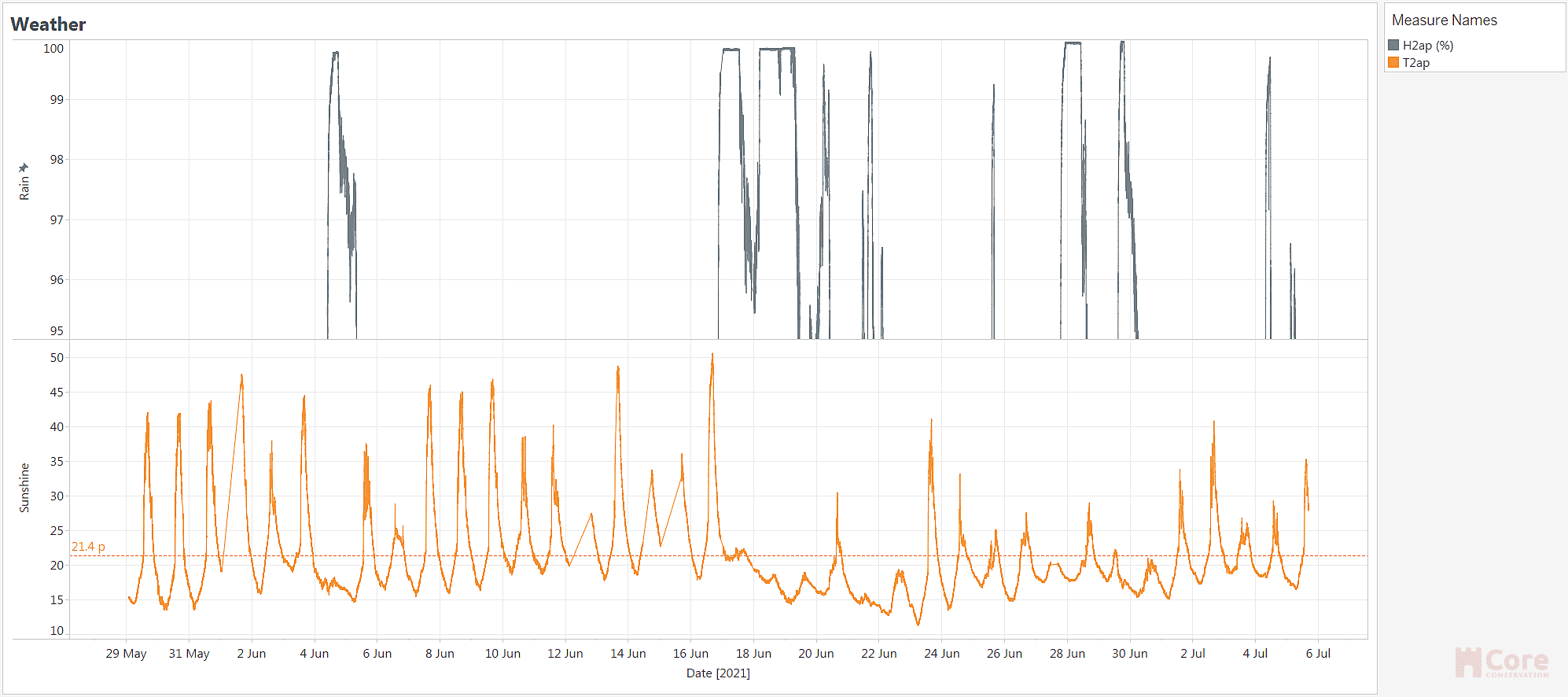
Ambient sensors measuring weather changes
Temperature Readings
Please see below comparative temperature readings taken from various parts of a wall:
- Left 2 graphs: comparing lower wall area temperatures, brick vs. mortar
- Right 2 graphs: comparing upper wall area temperatures, brick vs. mortar
- Each of these 4 graphs have two lines, comparing depth vs. surface temperature readings
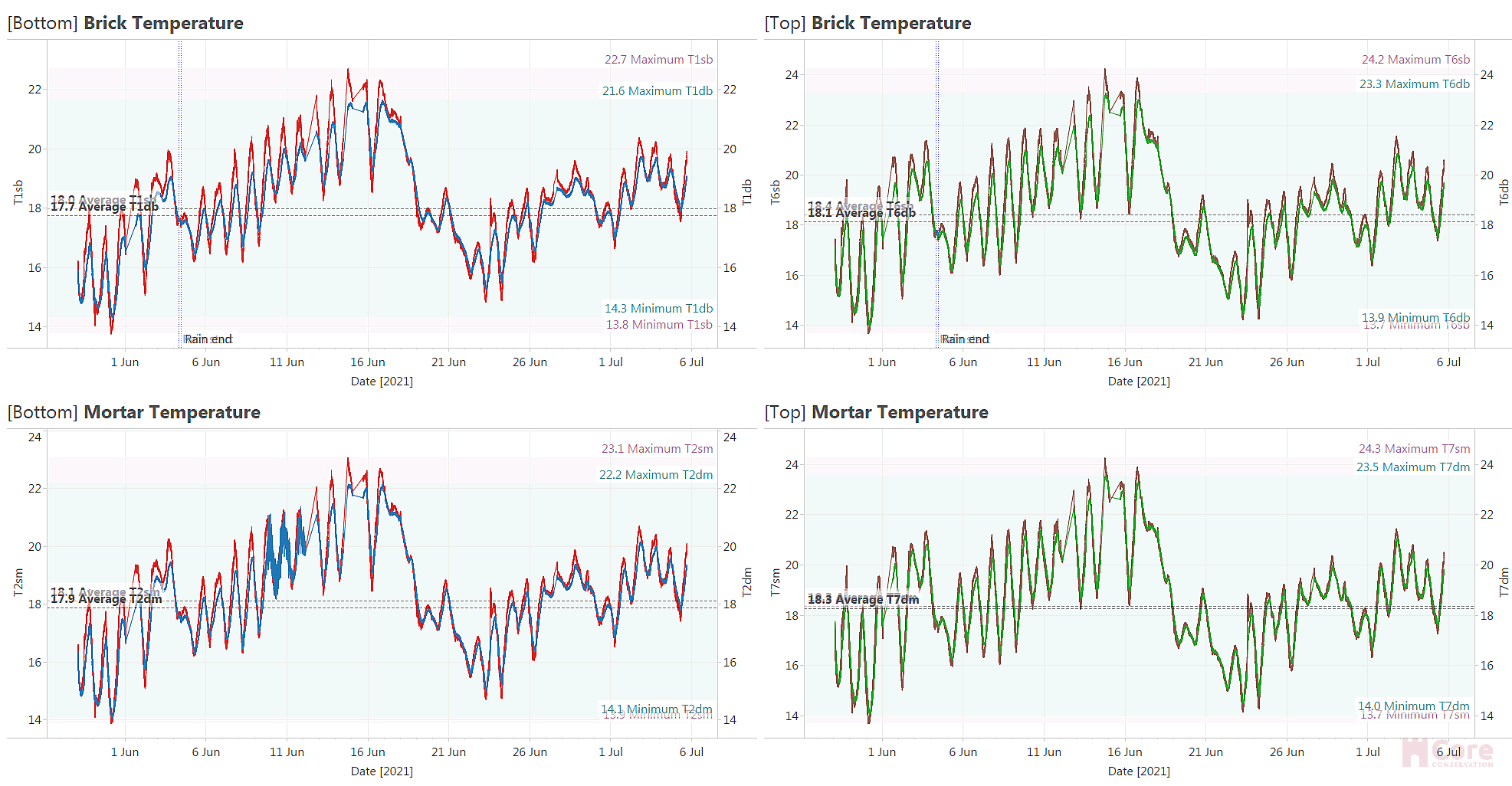
Temperature variations throughout the wall
Here are the key findings:
- Temperature variations throughout the wall are fairly even (the 4 graphs are very similar), however some differences are present.
- Near the ground (left graphs): the temperature of bricks and mortar is very close. The average depth temperature is 17.9 °C for mortar and 17.7 °C for bricks, a small 0.2 °C difference. The average surface temperatures are also very close: 18.1 °C for mortar, 18.0 °C for bricks, a small 0.1 °C difference.
- Higher up the wall (right graphs): the temperature of the wall higher up is slightly warmer (by about 0.4 °C degrees) than at the bottom. Surface temperature peaks at 24 °C (vs 23 °C for depth). The pattern of temperature changes is very similar between surface and depth.
Final conclusion: the temperature of the wall is about the same showing only minor variations (about 1 °C or less) between depth vs. surface, top vs. bottom and mortar vs. bricks.
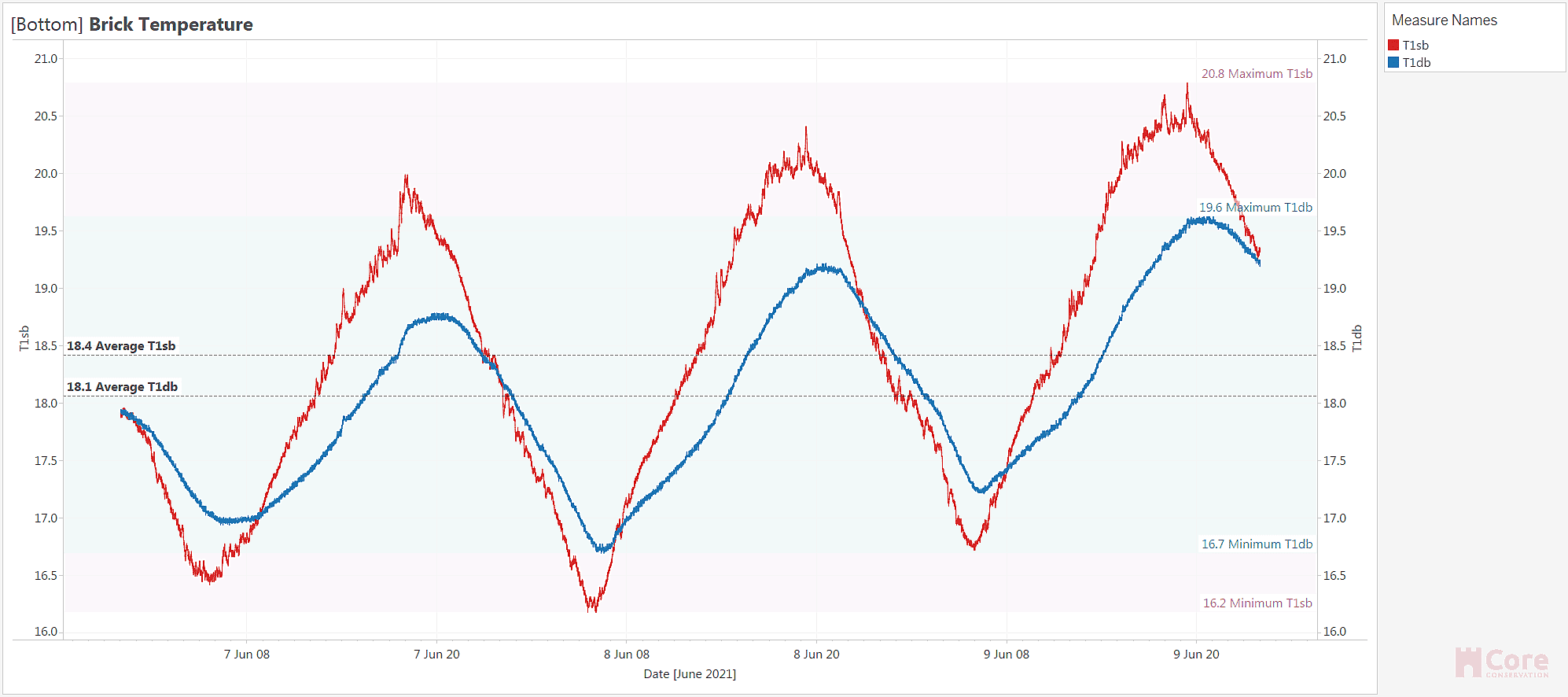
Fairly small temperature differences between surface and depth
Let’s look at humidity values next.
Humidity Readings
Unlike temperatures which are pretty much even throughout the wall, there are significant humidity variations between the upper and lower areas of the wall.
The comparative graphs below show the humidity readings of the wall:
- Left 2 graphs: comparing lower wall area humidities, brick vs. mortar
- Right 2 graphs: comparing upper wall area humidities, brick vs. mortar
- Each of these 4 graphs have two lines, comparing depth vs. surface humidity readings
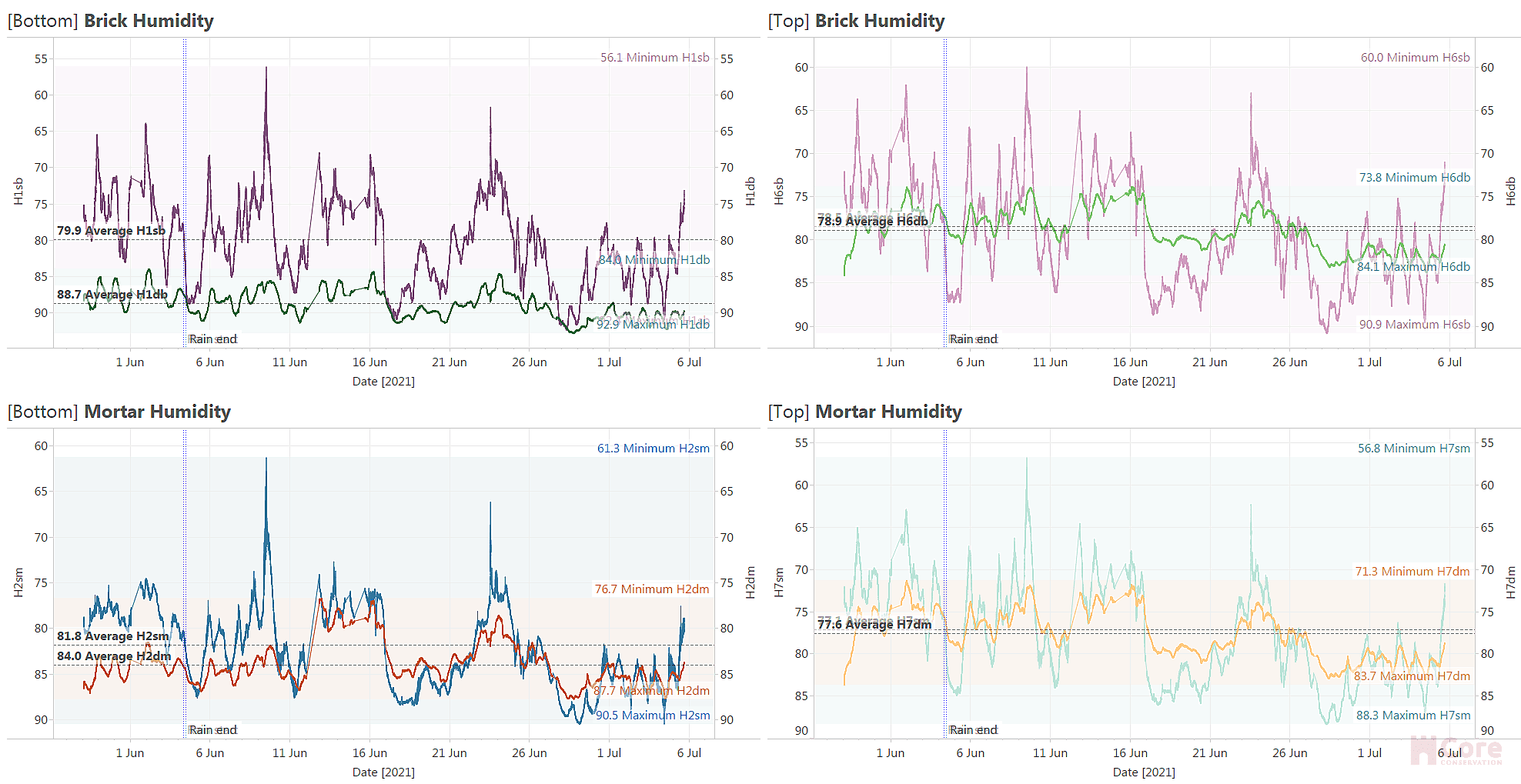
Humidity variations across the wall
Here are the differences between upper and lower wall areas:
Upper Wall Areas
- The depth of the wall (green band) shows much less variations than the surface (purple band). While surface humidity of bricks (purple band) shows a 31% change (between 60% to 91% RH), depth humidity (green band) variation varies much less, only 10% (between 74% to 84%).
- The surface of a wall can become drier or damper than the depth. The dry peaks of the surface (purple line rising over the green band) are driven by sunshine (gold). The damp peaks of the surface (purple line under the green band) are driven by rain (dark grey).
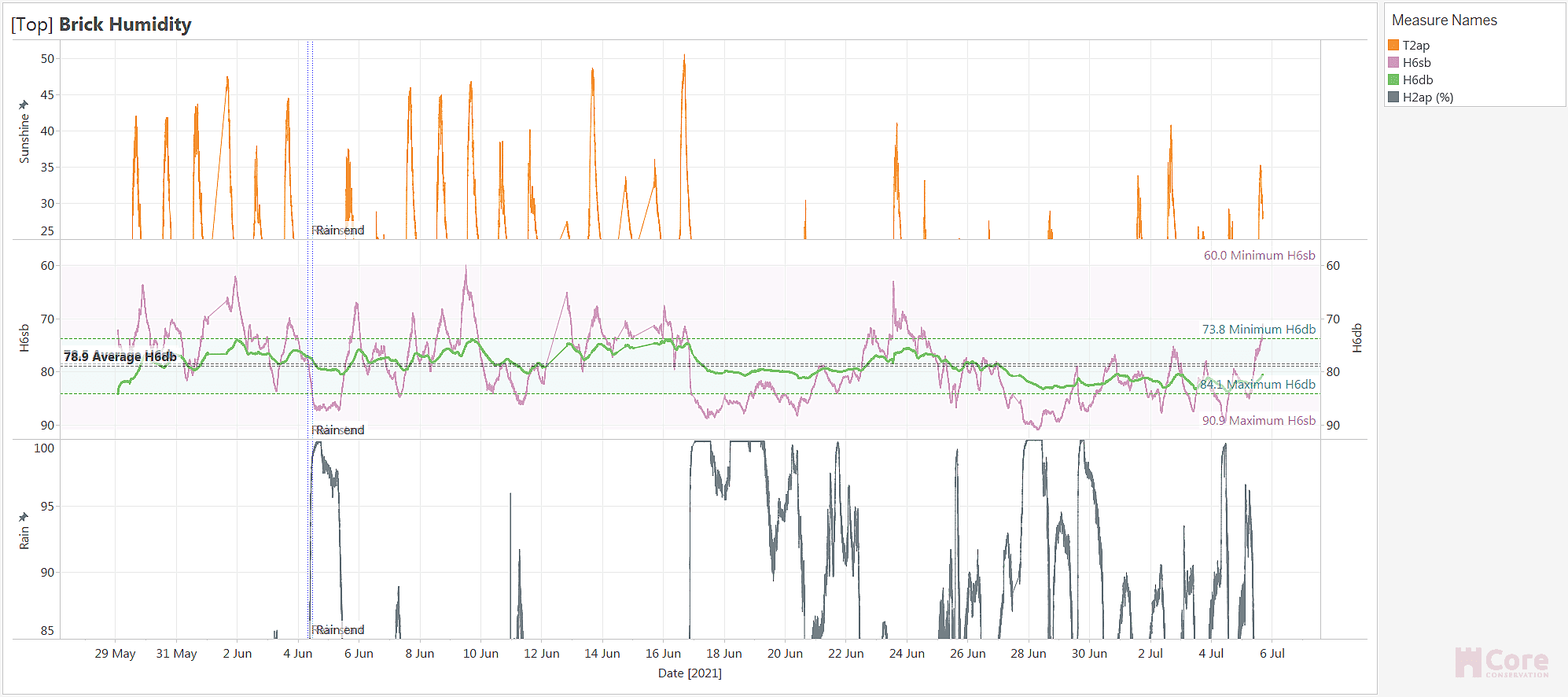
High humidity peaks are driven by rain, low humidity peaks by heat peaks
From here we can conclude, that:
- Surface humidity variation of higher wall areas are driven by ambient conditions. (e.g. heating, cooling, rain, sunshine, ventilation etc.), for both bricks and mortar.
- The effect of ambient changes is much less in depth (a 10% variation vs a 31% surface variation), the depth being much less affected by ambient changes.
Lower Wall Areas (Near-Ground)
Despite heating, in lower areas of the wall there are significant differences between surface and depth humidity.
Depth humidity variations are shown by the green line. Surface humidity variations are shown by the purple line. Min and max values of the variations are indicated by (overlapping) colored bands.
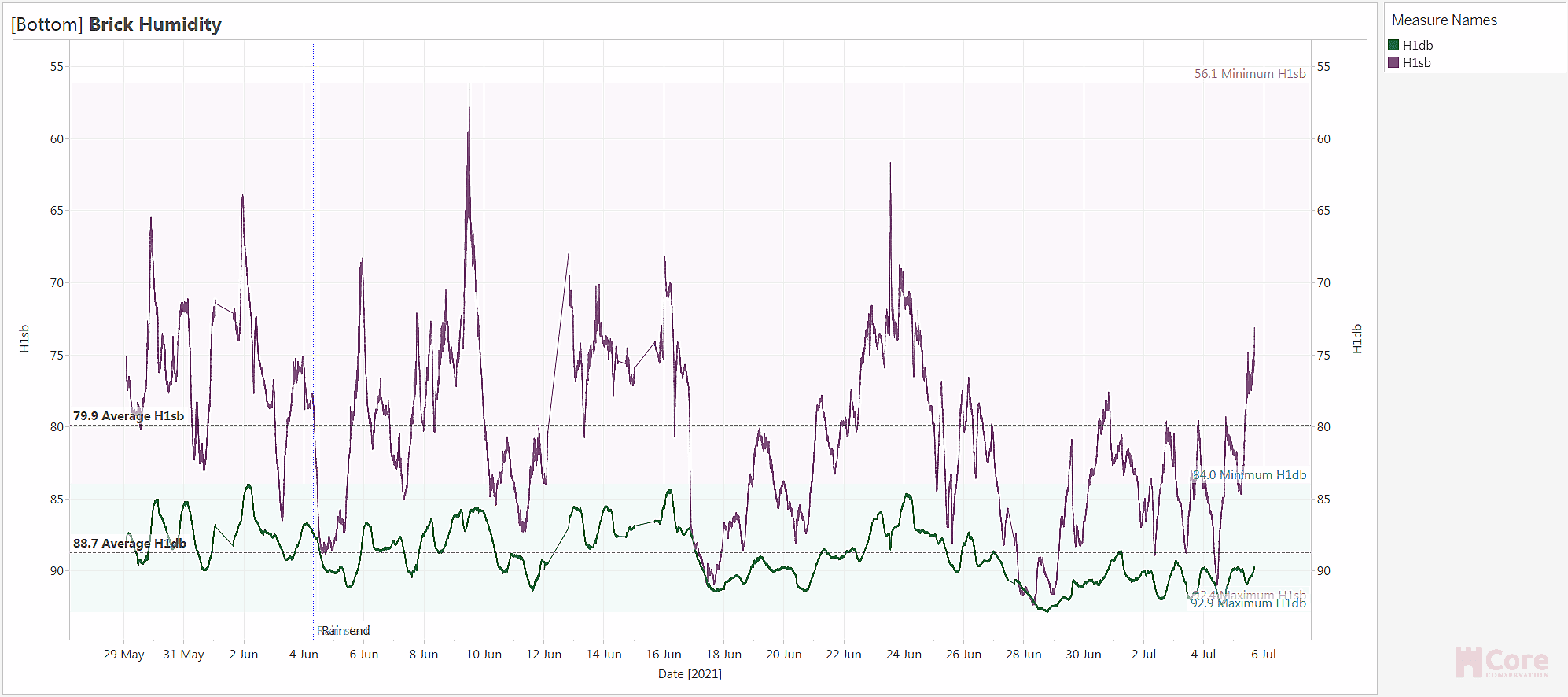
In lower areas the depth of the wall is much damper than the surface
The depth of the wall (green band) is showing much less variations than the surface (purple band). While surface humidity of bricks (purple band) varies 36% (between 56% to 92% RH), the depth humidity (green band) varies much less, only 9% (between 84% to 93%). These variations, although reduced, are driven by sunshine and rain peaks.
More importantly, the depth of the wall near the ground is always damper than the surface, despite heating (remember, the temperature of the wall in depth is only about 1°C less than the surface). This indicates that there must be an additional moisture source near the bottom, powerful enough to cancel out the effect of heating in depth. This moisture source is soil evaporation, described in more detail here.
What can we conclude?
- Surface humidity variations for both mortar and bricks are driven by the environment.
- Depth humidity variations for both mortar and bricks are driven by soil evaporation.
- Soil evaporation being a closer and stronger force overrides the effect of heating, being the main driving factor of humidity under the surface.
- As we go higher up the wall (away from the ground), the effect of ground evaporation in depth gradually decreases and the effect of the environment (heating, ventilation) increases.

Soil evaporation can override the effect of heating
Conclusions
- The temperature of our test wall was about the same throughout.
- The top and bottom of old walls behave differently, these areas having different drivers.
- The top of the wall is driven by ambient changes, the bottom of the wall by ground evaporation.
- The proximity of the ground overrides the effect of heating, ground evaporation being a much closer and stronger force than ambient heating.
- This explains why heating does not work well near the ground, while working quite well in upper areas.
- Heating can indeed keep wall surfaces dry, but does not work well for the depth of the wall.
- The fact that slow, steady heating can dry out the core of the wall near the ground was just an assumption based on incorrect observation of facts, assuming that just because a wall is dry on the surface it is also dry in depth. To assess the condition of a wall in depth special tools and measurements are needed (e.g. sensors, drilled core measurements etc.)
- The assumption that slow, steady heating can dry out the depth of the wall near the ground has been now conclusively proven to be incorrect.











